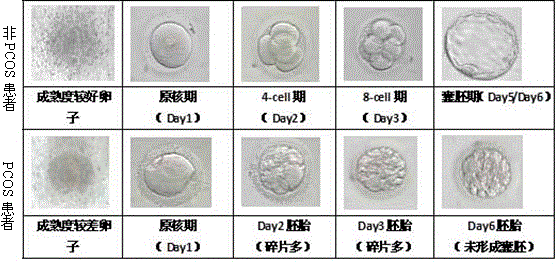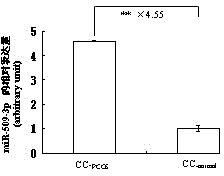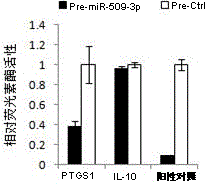Application of miR-509-3p expression inhibitor in preparation of polycystic ovary syndrome treatment drugs
A technology for treating drugs and inhibitors, applied in the field of application in the preparation of drugs for treating PCOS
- Summary
- Abstract
- Description
- Claims
- Application Information
AI Technical Summary
Problems solved by technology
Method used
Image
Examples
Embodiment 1
[0029] Morphological differences in the development of granulosa cells and oocytes between PCOS patients and women of normal childbearing age in Example 1
[0030] PCOS patients, especially PCOS patients with obesity, have abnormal oocyte morphology, thick cytoplasmic granules, and uneven thickness of the zona pellucida, resulting in low fertilization rate, uneven blastomere size and fragmented embryos after fertilization. More, slow cleavage speed or stagnant embryonic development, high-quality embryos cannot be obtained, which seriously affects the treatment outcome of these patients ( figure 1 ).
Embodiment 2
[0031] Example 2 Differential expression of miR-509-3p in granulosa cells of PCOS patients and normal women.
[0032] Total RNA was extracted by Trizol method, and after reverse transcription, real-time quantitative PCR was used to amplify and measure miRNA expression. The TaqMan probe method was used, and the reagents were primers and kits commercialized by Applied Biosystems (ABI) (reverse kit: name FG, Taqman (r) microRNA RT Kit200rxns, article number 4366596; PCR kit: name TaqMan Gene Expression Master Mix, Cat. No. 4369016; Reverse Primer and PCR Primer: Name MicroRNA Assays50RT+150PCR, Cat. No. 4427975).
[0033] Eight cases of newly diagnosed PCOS patients and eight normal women were collected, and the expression of miR-509-3p in granulosa cells was detected. It was found that the expression of miR-509-3p in PCOS patients was significantly higher than that in normal women, with a statistical difference (4.6±0.13vs1. 0±0.03, p figure 2 ).
Embodiment 3
[0034] Example 3 Dual-luciferase reporter gene system verification of the predicted target gene of miR-7
[0035] The target genes of miR-7 were predicted by Targetscan, PicTar and miRanda software. According to whether the biological functions of these target genes were related to hormone synthesis and ovulation mechanism, PTGS1 was selected as the target gene of miR-509-3p for verification.
[0036] Clone the 3'-UTR sequence of the predicted target gene PTGS1 of miR-509-3p, and add restriction sites XbaI (5'-TCTAGA-3') and NotI (5'-GCGGCCGC-3') at both ends of the primer . The primer sequences are as follows:
[0037]
[0038] The pmiRGLO vector (purchased from Promega) and the amplified sequence were subjected to XbaI and NotI double enzyme digestion, respectively. After the target fragments were recovered, the respective amplified fragments were connected to the vector to construct a dual luciferase reporter gene vector carrying the PTGS1 3'UTR region.
[0039] The c...
PUM
 Login to View More
Login to View More Abstract
Description
Claims
Application Information
 Login to View More
Login to View More - R&D
- Intellectual Property
- Life Sciences
- Materials
- Tech Scout
- Unparalleled Data Quality
- Higher Quality Content
- 60% Fewer Hallucinations
Browse by: Latest US Patents, China's latest patents, Technical Efficacy Thesaurus, Application Domain, Technology Topic, Popular Technical Reports.
© 2025 PatSnap. All rights reserved.Legal|Privacy policy|Modern Slavery Act Transparency Statement|Sitemap|About US| Contact US: help@patsnap.com



